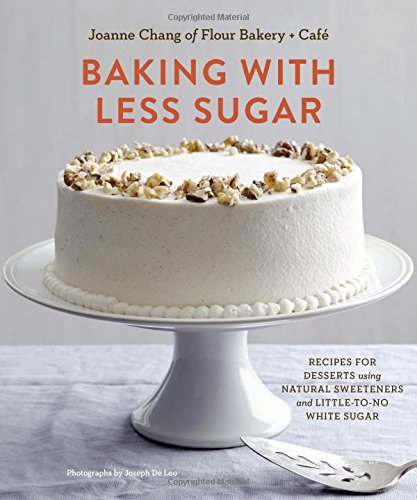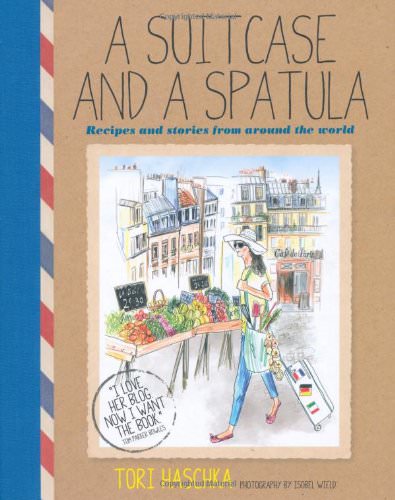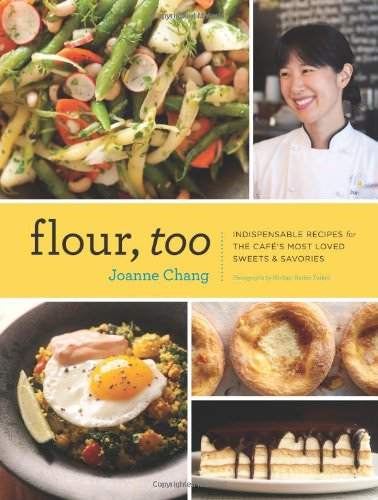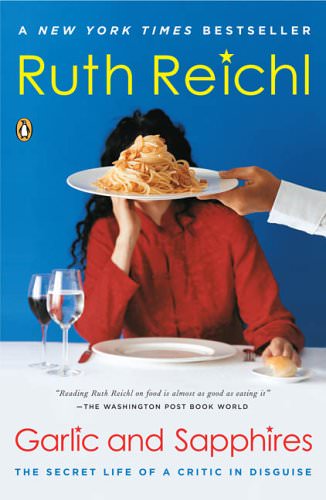Saturday September 12, 2015

Baking with Less Sugar: Recipes for Desserts Using Natural Sweeteners and Little-to-No White Sugar
The ingenuity and expertise of Joanne Chang, owner and pastry chef at Flour Bakery + Café, gets put on display in her third cookbook, Baking with Less Sugar. In America, we’ve come to depend upon sugar to bring flavor to our sweetened creations, but this reliance has only resulted in deadened taste buds and the masking of other ingredients. Chang sees this need to alter our cravings and has created a collection of recipes which challenge our palates to search for flavor elsewhere.
Chang starts her book by addressing the obvious disputes to this baking philosophy, saying that 1) “Life is sweet” and 2) “I sell sugar”. It’s true that owning a bakery, distributing innumerable confections daily, leaves Chang somewhat guilty for contributing to our sugar craze. However, she confronts this issue by explaining her own epiphany that baked goods can be sweet, and made more interesting, by substituting other ingredients for sugar - whether it be honey, maple syrup, or fruit purées. She believes that we negate the potential flavor of a cookie if we focus solely on making it sweet - it can be nutty, smoky, salty, anything on the spectrum of flavor. This introduction to her succeeding recipes has the reader excited for all of the new discoveries to be made outside of sugar’s constraints.
It’s hard to imagine a fruit pie without loads of sugar to make its filling sickeningly-sweet. Chang, however, is a strong believer in allowing the natural flavors of ingredients take center stage. She uses the built-in sweetness of the fruit in her Blueberry Nectarine Pie to make only 4 tablespoons of sugar all that is necessary for the jammy and luscious pastry. She pairs this with her Double-Crust Pie Dough, allowing the juicy berries to mix beautifully with its flaky texture.
Chocolate is certainly not without its own dose of sweetness, but by depending only on the sugar content of bittersweet chocolate in her Double Chocolate Whoopie Pies, she is able to significantly reduce the added amount from its traditional equivalent. Crème fraîche contributes a certain tangy bite, drawing the pies away from potential chocolate overload.
I love Chang’s use of maple syrup as a sugar substitute in her Sticky Toffee Pudding, a vegan alternative to honey. She outlines the traditional version she makes with “loads of brown sugar”, a comforting option during the colder months. However, she says that in this adaptation, the maple syrup complements the dates’ deep flavor instead of obscuring them in mountains of sugar as too many recipes often do. The dessert is a great example of how using natural sweeteners results in a greater complexity of flavor.
Baking with Less Sugar is not another cookbook focused only on making desserts with fewer calories. Joanne Chang seeks out alternatives for sugar so that she can experiment with other ingredients and develop recipes that taste how we expect them to, while still retaining an element of mystery in their subtle nuances of flavor. The result is healthy, delicious, and nonetheless sweet.
Saturday September 05, 2015

French Women for All Seasons: A Year of Secrets, Recipes, & Pleasure
Warning: for those of you looking for a quick-fix for your weight-management woes, French Women for All Seasons by Mireille Guiliano is not the book for you. Its pages replace this short-lived attempt at weight loss with a lifestyle that is sustainable, allowing readers to practice the French mentality of treating themselves to small indulgences in moderation.
She founds her ideology on a style of living based on incorporating healthy, feasible habits into everyday practice. Nothing about her plan is extreme, instead, she emphasizes the small, everyday treats we allow ourselves to enjoy, attributing success to the inclusion of small amounts of bread, Champagne, and chocolate in our daily diets. She provides helpful weekly menus for each season so that your meals stay consistent with the produce that is at its freshest and most delicious. Don’t feel constrained by these guidelines though, because they are just that, general directions for how to create a healthy relationship with food. Guiliano suggests that you learn what you like and build from there, because the real key to eating like a French woman is acknowledging that maintaining a healthy weight comes from the continual development of our joie de vivre, and appreciating the balance between restraint and pleasure that brings more joy to every moment and to every taste.
For those of us who have tested and tried all forms of yo-yo diets only to lose six pounds one week and gain it all back in the days immediately following, allow Guiliano to start by making food suggestions for you. What diet book would provide a recipe for Flourless Chocolate Cake, whose list of ingredients begins with equal amounts dark chocolate and unsalted butter (not to mention a cup of sugar to follow)? This is an example of Guiliano’s philosophy, where allowing ourselves to luxuriate in a small portion of a decadent dessert prevents us from giving into the temptation of a box of cookies later on.
The recipes are simple and straightforward, giving you plenty of options for weeknight cooking as well alternatives for more formal occasions. She provides a manageable Buttersquash Soup, with no more than six ingredients, but which she suggests dressing up with fresh parsley, grated nutmeg, and a dollop of crème fraîche if you’re expecting company.
French Women for All Seasons reads sometimes like an anthropological study of the differences between the French and American approaches to food, where the latter inhales entire meals in 10 minutes while the former has established the meal as a time for simultaneous reflection and celebration. Guiliano suggests that the difference arises not just in a focus on how our alimentation affects our culture, but the opposite. She extends her theories beyond food, noting that it takes recognizing pleasure in every aspect of our lives, in romance, our family, friends, and even the mysterious bloom of cherry blossoms in spring, to feel completely engaged each moment and entirely satisfied with every meal.
Saturday August 29, 2015

A Suitcase and a Spatula: Recipes and Stories from Around the World
Though we can’t all pack our bags and head off to Paris when a hankering for French culture arises, it is within our ability to be transported by a single bite of a flaky and light, buttery croissant. Or how about Raspberry Croissant Pudding? This is exactly what food and travel writer Tori Haschka wants to give her readers in A Suitcase and a Spatula. Her recipes make even the most far-off travel destinations accessible, all through the sense of taste.
Haschka believes, just as I do, that our palates have a direct connection to our memories and imaginations. Highlighting the ingredients and flavors exclusive to the destination, Haschka uses her recipes to carve out and put on display the region’s cultural landscape. Peppers spiced with the heat of a red chili in Baked Moroccan Eggs evokes the warmth of the coast of Agadir, while the distinctive bitterness of the liqueur in her recipe for Sardines with Campari, Peach and Fennel raises images of enjoying a Spritz or Bellini in a Venetian Bar. The dish itself is pictured plated simply atop a white dish, allowing its brightness of color and flavor to take focus among vintage china plates stacked to the side.
I love cookbooks that go beyond simply giving measurements and proportions, ones that surpass a list of ingredients and instructions by including light but thoughtful prose. Doing so intertwines food and experience, showing the former’s deep profundity and effect upon our lives. Haschka applies this in her reflection of Menton in the south of France, where she describes the outpour of beauty in its abundance of flowers and the restorative effects of mussels and rosé, a food and drink combination that became the cure to her flu when she visited. Her headnote for her Mussels, Fennel, and Chickpeas in Pink Wine serves as a precursor for the joy that is to come, stating that “No matter how you were feeling when you started, healthy contentedness comes from this.”
A Suitcase and a Spatula lets you take a vacation from your kitchen, allowing you to experience the food and world beyond your stovetop. Tori Haschka provides you with two invaluable gifts: a life well-traveled and a body well-fed.
Saturday August 22, 2015

Flour, Too: Indispensable Recipes for the Cafe's Most Loved Sweets & Savories
We all have that favorite spot -- the breakfast place around the corner, the coffee shop up the street, the bakery with the awe-inspiring case of baked goods staring back at you. Joanne Chang’s Flour Bakery + Café in Boston is all of these, but it has established itself beyond sweets and breakfast confections alone. Flour, Too is Chang’s second cookbook, following the success of her first, Flour. Though recipes categorized under “Sweets” and “Desserts” dominate its pages, the cookbook spreads its focus to the savory as well. With recipes like the Classic Split Green Pea with Smoked Ham soup or the Mushroom and Leek Lasagna with Creamy Béchamel, you quickly gain the sense that Chang isn’t trying to overwhelm your sweet tooth, but rather provide you with the comfort and nourishment of food.
You can mimic the most loyal of Flour’s customers and use the book to follow the daily experience of the bakery. Start with a stack of CJ’s Spiced Banana Pancakes, which are perfectly moist and not overly-sweet from the natural flavorings of the fruit and are matched with the underlying smokiness of allspice and black pepper. A drizzle of maple syrup as the accompanying image suggests is all you need to make resisting these fluffy delicacies impossible. You can take the savory route for lunch with an updated American classic -- the Applewood Smoked BLT. Chang complements the salty-sweet bacon with the added pepperiness of the arugula. Dinner can become a more complex affair, beginning with the colorful Heirloom Tomato Salad, stepped up with feta, watermelon, and a delicious Red Wine Vinaigrette. The main dish options include a Slow-Baked Atlantic Salmon with Tabouli, whose inventive cooking method gives the fish, as Chang puts it, “a delicate, buttery texture and flavor.” End the evening just as you began, with a small, two-bite French Macaron. Crisp and light, satisfyingly sweet.
Flour, Too invites us to sample a sugar-specked brioche and instills a desire to test the elasticity of Chang’s focaccia dough. Every page is a representation of the ease and contentment enjoyed in passing the time at one of the Flour locations. Use the book to bring to your kitchen the iconic smells and tastes of the bakery -- a place many people already consider home.
Saturday August 15, 2015

Lunch in Paris: A Love Story, with Recipes
Food memoirs are among my favorite genres. They connect food to our relationships, experiences, and lives. Elizabeth Bard follows this in her first book Lunch in Paris, by interspersing the memories of falling in love with a charming Frenchman, Gwendal, with traces of her culinary journey marked by recipes of her past and the ones she gains along with embracing a new culture. The dishes are inspired by the fresh ingredients from Parisian markets; they contrast the fussy, complicated reputation of typical French fare. This focus allows Bard to not only write about international cuisine, but about international living, and how she discovers French culture from her time around the table, whether it be during a meal, at a market, in a restaurant, or only in a single taste itself.
The recipe for Gwendal’s grandmother’s, Mary Simone’s, tabouleh, shows the memoir’s function as a family recipe book, giving the tricks of culinary techniques passed down through generations. The secret to this dish is replacing the bulgur with couscous, lightening the salad and mixing well with the acidic, slightly sweet taste that Bard confessed to me she loves. This coming-together of the savory and sweet shows the gustatory connectivity of food, but in Bard’s descriptions of food and the narrative that follows it, we discover the French culture alongside her own discovery of their passion for cuisine: for good, simple food done right.
Her new book Picnic in Provence, came out this spring. I can’t wait to read it and share my thoughts with you!
Saturday August 08, 2015

Garlic and Sapphires: The Secret Life of a Critic in Disguise
In Garlic and Sapphires, Ruth Reichl has the reader hooked by the first page, working through the inedibility of her first food description: “... a squishy brown square of meat surrounded by a sticky stockade of potatoes that might have been mashed last year. The wrinkled gray peas look as if they were born in a laboratory test tube. The roll glows with such an unearthly lunar yellow that I can feel its chill before my fingers even touch the surface. The lettuce in the salad has gone brown at the edges, and the tomatoes are too tired to even pretend that nature intended them to be red.” Reichl, however, moves quickly past this vignette and the immediacy of the food itself, and delves further into the book’s primary focus: the importance and challenge of anonymity in being America’s most well-known food critic.
She reflects upon her hilarious and heartfelt experiences in some of the greatest restaurants in the world, all the while trying to navigate the intersection of public and private life. She supplements this narrative focus with deliciously elegant but approachable recipes, giving the reader a greater understanding of the techniques and flavors Reichl puts to paper. The book’s final recipe, “Last-Minute Chocolate Cake” speaks for itself, with the spice of the unsweetened chocolate, the intensity of strongly-brewed coffee, and the contrastingly sweet bitterness of Grand marnier, all it needs is “a scoop of vanilla ice cream on each slice” to result in something worth writing about.
From her writing, it’s obvious that Reichl is a profound appreciator of food, and a lover of the joy it brings to her everyday life: “My yogurt was nestled into a bag, waiting to turn into aushak, and all around us were sausages and pastry, lollipops and spices, chicken and cheese. Any world that contained all this, I thought surveying our loot, was a very fine place. I felt reinvigorated, alive, optimistic. The thought of getting back to work suddenly seemed like fun.” Because the reader is introduced to this perspective so early on, we ask the same question Reichl tries to understand herself: how do you tell someone what they should know about a restaurant, and more importantly, the food they will eat there, if everyone is lingering behind your back watching you do it?
Page 4 of 6 pages ‹ First < 2 3 4 5 6 >











